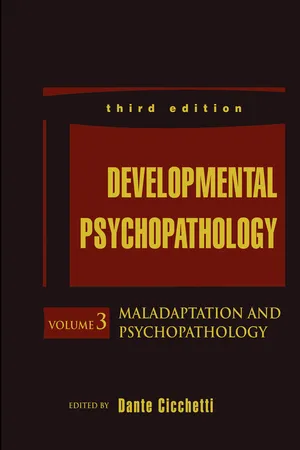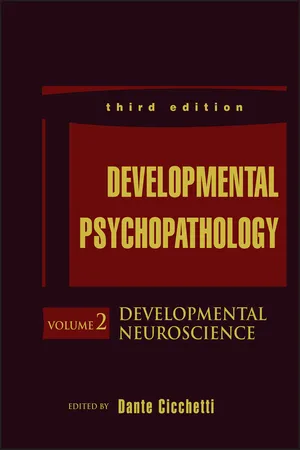Psychology
Psychological Perspectives and Etiology of Disorders
Psychological perspectives on the etiology of disorders refer to the various theoretical frameworks used to understand the origins and development of mental health conditions. These perspectives include biological, psychodynamic, behavioral, cognitive, and sociocultural approaches, each offering unique insights into the causes of psychological disorders. By examining these perspectives, psychologists can gain a comprehensive understanding of the complex interplay of factors contributing to mental health issues.
Written by Perlego with AI-assistance
Related key terms
6 Key excerpts on "Psychological Perspectives and Etiology of Disorders"
- eBook - ePub
Understanding Psychology for Medicine and Nursing
Insights and Applications
- Mohamed Ahmed Abd El-Hay(Author)
- 2019(Publication Date)
- Routledge(Publisher)
The classification is called diagnosis, and the methods used to try to change the behavior are called therapies. If the deviant behavior ceases, the patient is described as cured. This way of talking about psychological abnormality reflects the medical model of thinking, where abnormal behavior is seen as indicative of an underlying illness. However, when we label people as sick or ill, we are removing from them all responsibility for their behavior, just as we do not normally hold someone responsible for having the common cold. Conclusion: because of difficulties defining a specific set of behaviors that everyone, everywhere, will agree to consider as abnormality, and as no single criterion or perspective is entirely adequate in identifying abnormality, it is appropriate to combine aspects of different perspectives. Thus, the person’s behavior, emotional reaction, and the consequences of the behavior of that person are to be considered within the sociocultural context of the person. The effect of age, gender, and culture, as well as the effect of a particular situation and the historical era in which people live should be considered to define what is appropriate when defining the words “appropriate,” “expected,” and “functional” behavior. Etiology of Psychiatric Disorders Attempts to understand the etiology of psychiatric disorders generally fall under one of the three broad perspectives: 1. Biological perspective (medical or disease model) : this explains psychological disorders in terms of particular disturbances in the anatomy and chemistry of the brain and in other biological processes, including genetic influences (e.g., Plomin & Asbury, 2005; Plomin & McGuffin, 2003). The medical model gave rise to the idea that abnormality is a mental illness - eBook - ePub
- Alan Clarke(Author)
- 2013(Publication Date)
- Routledge(Publisher)
Expert definitions of mental illness vary both between and within the disciplines of psychiatry, clinical psychology and psychoanalysis. A description of the various approaches is beyond the scope of this chapter. The intention here is to establish the fact that mental illness is a contested concept. What the different perspectives have in common is that they attempt to identify what constitutes mental illness and speculate as to its causes. However, the nature and content of the explanations they offer is to a large extent determined by the conceptual framework adopted. In terms of the aetiology of mental illness it is possible to make a broad distinction between the biologically oriented explanations and those that are based on social or psychological factors.Although there are different schools of thought within psychiatry, a medical or biogenic conceptualisation of mental illness as a predominantly biological condition prevails. According to this view the causes of mental illness lie very much within the individual. Explanations are presented in terms of biochemical imbalances, genetically inherited abnormalities, neurological impairment or organic malfunctioning. One consequence of the medical model is that, in one sense, it encourages us to look at mental illness in the same way that we view physical illness. There is a tendency to see mental illness as resulting from some underlying physical pathology, with the illness revealing itself in the form of mental symptoms. Following a diagnosis of the ‘disease’ on the basis of the observation of the symptoms, the psychiatrist recommends a treatment to cure the condition or alleviate the symptoms. Such an all-embracing concept of mental disorder as an ‘illness’ can lead to diagnosis and treatment being viewed as mechanistic procedures, and the individual sufferer being regarded as the passive carrier of a disease.The adoption of what Rogers and Pilgrim (2005) call an ‘illness framework’ in psychiatry can be problematic as there are qualitative differences between physical sickness and mental illness.A fundamental problem with the illness framework in psychiatry is that it deals in the main with symptoms not signs. That is, the judgements made about whether or not a person is mentally ill or healthy focus mainly (and often singularly) on the person’s communications. - eBook - ePub
Psychology and Crime
A Transdisciplinary Perspective
- Craig Webber(Author)
- 2019(Publication Date)
- SAGE Publications Ltd(Publisher)
2 Psychological Perspectives on Crime Overview Moving on from a historical overview of social scientific understanding of crime, this chapter looks at the different psychological perspectives that constitute psychology. We will see that although they are sometimes presented as discrete areas of research, in fact there is some significant overlap between them. If we want to understand the problem of many accounts of crime, both sociological and psychological, then we can interrogate them through the lens of age. One of the key criminological truisms is that most people grow out of crime (Rutherford 1986/2002). This will be a recurring theme of this chapter so that the different psychological perspectives can be understood through issues like aging and desistance from crime. Key terms ■ Psychological Perspectives; Biological Psychology; Behaviourism; Cognitive Psychology; Psychoanalysis; Social Psychology The previous chapter explored the main approaches to understanding crime as they developed historically; this next chapter is a more in-depth overview of some of the major psychological approaches to studying human behaviour. This is not meant to be an exhaustive overview, merely a reminder for those who have already studied psychology, and an introduction for those who have not. All psychological approaches share the common focus of studying internal mental processes. Psychology can be distinguished from psychiatry through the latter’s focus on the study and treatment of mental illness and emotional disturbance. Psychiatry is a branch of medicine that, for the most part, focusses on illness and derivations from ‘normal’ 1 behaviour. Psychology is interested in a broader range of human behaviour that includes mental functions such as perception (e.g. taste, colour or object sizes), the capacity and ability of memory, as well as behaviour that some might describe as ‘abnormal’ such as aggression - Dante Cicchetti(Author)
- 2016(Publication Date)
- Wiley(Publisher)
DSM nomenclature since 1980); and (6) are often the result of poor parenting practices (e.g., severe discipline, childhood sexual abuse).Scientific inquiry into the nature of personality disorders was relatively somnolent prior to 1980, with most energy directed toward theory (without concomitant empirical research) and clinical treatment issues. A sea change occurred with the advent of explicit diagnostic criteria for the personality disorders in the DSM-III (American Psychiatric Association, 1980). While the diagnostic criteria for personality disorders in the DSM-III were not formally operational as has been asserted by some, they were clearly articulated and provided a rubric for the identification of clinically significant deviations in personality functioning. Scientific inquiry into the definition, classification, and nature of personality disorders really began in earnest in the era ushered in by the DSM-III. By the mid-1980s the personality disorder research area found itself largely concerned with debates regarding the proper definition of PDs (e.g., categories vs. dimensions?) as well as the refinement and continued development of diagnostic instruments for the assessment of PDs. This was so because the PDs had only recently been defined explicitly (i.e., DSM-III, APA, 1980) and instrumentation for reliable assessment had only just begun to emerge (forerunners of the IPDE, SCID-II, and SIDP). At that time, there was also a growing scientific interest related to factors impacting the diagnosis of personality pathology, for example, (1) the comorbidity of PDs with Axis I disorders; (2) the challenging reality of multiple personality disorders in the same individual; (3) the utility of interview versus self-report assessment instruments (Zimmerman, 1994); and (4) possible sex/gender bias in the definition/diagnosis of PD's (see Lenzenweger & Clarkin, 2005, for review). Many of these issues continue to be of concern even today and were, indeed, taken up in the attempted revision of the personality disorders section of the recently published DSM-5- Dante Cicchetti(Author)
- 2016(Publication Date)
- Wiley(Publisher)
DSM-5 are also readily apparent. Many of the criteria are no more than a reflection of the conventional wisdom of a committee of experts with limited empirical justification. Being categorical in nature, it largely ignores the dimensional properties of many syndromes and their intimate relationship with environmental factors and the individual's antecedent developmental history.Perhaps most disappointing is its failure to provide a dynamic framework that would allow for a sensible dialectic with burgeoning areas of science including evolutionary biology, molecular genomics, environment-dependent epigenetic alterations of gene expression, systems and developmental neurosciences, neuroimmunology, ethology, child development, and cognitive and social neuroscience—to name a few. Despite these shortcomings there is an increasing recognition that there is a need to look beyond the proximal mechanisms that underlie specific disorders and to consider the distal evolutionary mechanisms that give rise to psychopathology (Stein & Neese, 2011). In this chapter the primary focus is on these emerging perspectives on how evolutionary processes may support the preservation of various forms of psychopathology.Goals of Evolutionary Explanations
The principal goal of an evolutionary perspective of psychopathology is to provide a coherent framework from which to view patterns of maladaptive behavior that are persistent in human populations (Leckman & Mayes, 1998). In such an evolutionary framework, the issue of persistence appears to be paradoxical given the editing power of natural selection. Darwin's (1859) principle of natural selection posits (1) the existence of variation among individuals, (2) differential reproductive success for those individuals who exhibit traits that are useful in the struggle for life, and (3) differential inheritance of those factors that gave rise to the favorable traits. Why then would particular variations persist that place individuals at a reproductive disadvantage in the struggle for life? We also need to consider whether various forms of psychopathology are not truly maladaptive when viewed from an evolutionary perspective. As pointed out by Belsky and Pluess (2013), some forms of behavior that are generally considered to be psychopathological and maladaptive (e.g., impulsive, risky, antisocial) can be considered adaptive within certain conditions of adversity to the degree that they enhance an individual's reproductive fitness- eBook - ePub
Child and Adolescent Psychology
Typical and Atypical Development
- Stephen von Tetzchner(Author)
- 2018(Publication Date)
- Routledge(Publisher)
2 THEORETICAL PERSPECTIVESThis chapter provides a brief introduction to the foundations of theory formation and the most important theoretical perspectives in developmental psychology: psychodynamic psychology, behaviorism, logical constructivism, social constructivism, evolutionary psychology, ethological psychology, ecological psychology, information processing and critical psychology. They differ in their emphasis and explanations of developmental phenomena and together they illustrate the breadth of developmental thinking in the twenty-first century. Each of them comprises many assumptions and hypotheses, and constitutes a basis for many smaller theories.The theories are presented in more detail in parts of the book where they are relevant, including critical comments. Chapter 10 , for example, discusses the cognitive aspects of the theories, while Chapter 18 discusses the development of personality.THE FUNCTION OF DEVELOPMENTAL THEORIES
Developmental theories are intellectual tools for categorizing and making sense of observations of children’s actions and reactions and their environment, and explaining typical and atypical developmental trajectories. As all tools, they must be functional and solid. A good theory requires a coherent set of interconnected concepts and a terminology that can be used to describe the development of the psychological phenomena and explain the relevant processes, for example concepts that can characterize children’s changing thinking or emotion understanding, and the processes that underlie these developmental changes (see Chapters 10 and 17 ). “The usefulness of theories may be evaluated in regard to its attributes of precision, scope and deployability” (Lerner, 2002, p. 11).According to Popper (1959), a theory has to be testable in order to be scientific. The first test of whether a theory is sound and tenable is to establish if it can account for and integrate existing research findings (Lerner, 2002). Popper also points out that theories cannot be proven
Learn about this page
Index pages curate the most relevant extracts from our library of academic textbooks. They’ve been created using an in-house natural language model (NLM), each adding context and meaning to key research topics.





